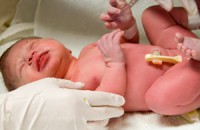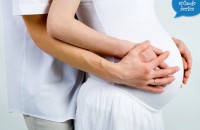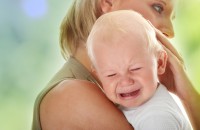Newbies
Should I Eat My Placenta?
[00:00:00]
Please be advised, this transcription was performed from a company independent of New Mommy Media, LLC. As such, translation was required which may alter the accuracy of the transcription.
[Theme Music]
NOVA CONTE: You did it. You had your baby and then you birth your placenta. Now what should you do with it? Should I have my provider whisk it away to the pathology lab or should I consider taking it home and consuming it? Should I eat my placenta? I'm Nova Conte, certified placenta encapsulation specialist, certified postpartum doula and certified lactation counselor. You're listening to Newbies.
[Theme Music]
KRISTEN STRATTON: Welcome to Newbies broadcasting from the Birth Education Center of San Diego. Newbies is your online, on-the-go support group guiding new mothers through their bay’s first year. I'm your host, Kristen Stratton. I'm also a certified birth doula, post partum doula, VBAC coach and owner of In Due Seasonal Doula Services.
If you haven't already, be sure to visit our website at www.newmommymedia.com and subscribe to our weekly newsletter. You can also subscribe to our show through iTunes so you'll automatically get new episodes when they're released. Sunny is here to tell us about other ways you can participate in our new show.
SUNNY GAULT: Alright. Hi everybody. We have different segments that you guys can get involved with because we love our listeners to be part of our shows. One segment is called “Ask the Experts”. Whatever questions you have related to having a newborn, or caring for your newborn or perhaps you're going through something postpartum that you have questions on, we have a whole team of experts that can answer your questions for you. So we'll take your question, we'll pair it with an expert and we'll get that question answered. Then we'll put it in an upcoming episode.
Of course we'd love to hear from our listeners in other ways too. If you have story ideas—since the show just launched, we are looking for story ideas, episode ideas. So let us know the type of topics that you want to learn more about and we'll get them scheduled for a future episode.
[Theme Music]
SUNNY GAULT: Hey Newbies. On our Facebook page we have been asking you guys to share your birth stories. And I know everyone has different birth stories. Sometimes they can be kind of long. So we created a segment called “5 Minute Birth Stories”. We would love you guys to submit to it. We have one submission today and this is from Theresa from Houston. Theresa, I love that you called our voicemail. Because we can actually hear your voice and you can tell your own story. Theresa actually has a pretty cool story about her daughter that was born and actually had the umbilical cord wrapped around her neck. So here's Theresa.
THERESA PAPERTON: Hello. My name is Theresa Paperton. I live in Houston, Texas in the United States. I was calling in response to a Facebook post about the new mommy stories. During my birth, my daughter was born with the umbilical cord wrapped around her neck three times. She was not breathing when she came out. They did CPR on her for 10 minutes before they heard a sound come out of my child. They finally saved my child.
She is a wonderful addition to my family, a very lax puzzle piece. She is now 2 ½ years old and is an amazing part of my life and my children's life. Her name is Phoenix Laine and she is amazing.
SUNNY GAULT: Again Theresa, thanks so much for sending that in. If you're a mama listening to this and say “You know I have a birth story I would like to share”. We would love to hear from you guys and the best way to share it I think is via voicemail. That number to call is 619-866-4775. It will go straight to voicemail.
You don’t have to talk to anyone. Just in five minutes or less, you can share your whole birth story if you can squeeze them in five minutes or a portion of it that was really important to you. Something that's encouraging and can help other mamas out there. Again,thanks so much and we hope to hear from you soon.
[Theme Music]
KRISTEN STRATTON: Today on Newbies, we're discussing should you or should you not eat your placenta? Joining us today is Nova Conte who is a certified placenta encapsulation specialist and owner of Womb Service in San Diego California. Thanks so much for joining us Nova and welcome to the show.
NOVA CONTE: Thank you.
KRISTEN STRATTON: Nova first of all, what is the placenta?
NOVA CONTE: Actually the placenta is so interesting. It's the only time that we as humans grow an additional organ for a certain period of time. When our body is done using it, actually releases the organ. The placenta is an organ that connects the fetus to the uterine wall and supplies oxygen, nutrients all to the fetus through the blood travelling down the umbilical cord of course connecting at the baby's belly button. The placenta also produces and regulates all of the hormones through pregnancy.
KRISTEN STRATTON: What typically happens to the placenta after the baby is born?
NOVA CONTE: Usually the placenta—the doctor or midwife does do a quick exam, kind of going over the placenta to make sure that it looks healthy, but mostly making sure that the placenta did come out either completely or intact. Making sure that there are no pieces left over in the uterus and if they do see that there are pieces left over, they might go into the uterus and retrieve them and possibly use an ultrasound to make sure that the uterine wall is completely clear and empty.
KRISTEN STRATTON: Can you tell us a little bit of the history of placenta consumption and what methods are available to moms to consume their placenta?
NOVA CONTE: It's interesting. We have a lot evidence that – different cultures—people from Egypt and Jerusalem way, way back started consuming their placenta. Of course not in encapsulation form but in raw form. It's definitely been historically popular in traditional Chinese medicine. Lots of cultures have used their placenta for centuries.
In the 1970s it became really popular in the United States popularized by midwives and other alternative health practitioners. Certainly in the last five years, it’s gained a lot of popularity partly attributed to certain celebrities that have consumed—Kim Kardashian, January Jones, Alicia Silverstone. It's been really interesting. Moms really just talking about their experience with consuming their placenta. That's kind of a bit of the history especially in the United States.
KRISTEN STRATTON: How do people typically consume it? What's the common way that people will consume their placenta?
NOVA CONTE: As far as the different methods of consumptions to mom, you can actually eat part of the placenta raw just right after the birth. The maternal side is mostly just meat. So you are able to actually just pick parts off of the placenta of fresh meat. Either put it in your mouth and chew it and swallow it or have it immediately after birth as a smoothie.
Of course there is placenta encapsulation which is basically cleaning and dehydrating the placenta meat and grinding it up into a fine powder and placing it into capsules. There are placenta tinctures available which is basically suspending the placenta in a high grade of alcohol and essentially fermenting the placenta in the alcohol for long term use.
SUNNY GAULT: So Kristen, I know that you do the placenta encapsulation now. But did you actually try it before? Did you go through this whole process as a client or a patient before you actually did it in your own for other mamas?
KRISTEN STRATTON: I didn’t. In all honesty the first time I heard about this, I thought it was absolutely gross. Just where I was at in my journey and then by the time I got to baby number three, I actually had someone offer, not to do it for free, but offered as a service. I thought it was kind of pricey. I don’t really need that.
And the night of having horrible postpartum depressionand postpartum anxiety so when I started talking to women who had done it, I thought there might be something to this. Then I made the decision to start offering it up as a service and then I really got some positive feedback. I kind of kicked myself for not trying it.
But I’m hoping people will benefit from my wisdom which is just at least try it. Just take it home with you because once it's gone, it's gone. Worse case scenario, buy it under your tree or you hire someone and you can get it encapsulated for three months postpartum. Definitely give yourself the luxury of making that decision before it's made for you.
SUNNY GAULT: Yes. Especially if you're kind of on the fence now, because you'll never know. I mean if you start to feel that postpartum depression or the baby blues or whatever right there in the beginning, that may be the deciding factor and see, how do I feel after my baby comes? Maybe I hate it, maybe I don’t. But like you said, if you don’t have the placenta, you don’t have the option. Hospitals love to whisk those things away.
KRISTEN STRATTON: They're gone in 30 seconds.
SUNNY GAULT: It is. It's that biohazard—
NOVA CONTE: Yes it is. They put it in that scary biohazard bag. Sometimes for us encapsulers for picking up.
KRISTEN STRATTON: No way you're serious?
NOVA CONTE: It's a little excessive but you had yours done didn’t you?
SUNNY GAULT: I had it done with my second. I’ve got four kids. With my first though, I don’t know it it's officially postpartum depression. I don’t really know what it was because it was my first baby and I really didn’t know what to expect. But I really just wasn’t feeling good afterward and I had some postpartum issues in general. Just from having the baby and I needed a couple of surgeries afterward because I kind of got messed up.
Anyways, there was a lot emotionally going on with me and so I don’t know if it was triggered by that or whatever. But I was just not feeling right. I think my son was three or four months and I still really wasn’t feeling right. I wasn’t able to really exercise and do the stuffs that I would normally do to feel better.
Even through doing these shows, I started to learn more and more about it. I was kind of grossed out by it too, because this sounds just really weird honestly. Until you really start to learn more about it and know that we are the only mammals that don’t actually eat their placentas normally right? Then it starts to make a little bit more sense.
If you can get over a little bit of that hump of “oh my gosh” looking at pictures. Don’t Google placentas necessarily online and just stare at pictures?
KRISTEN STRATTON: Unless you actually appreciate how many amazing it is.
NOVA CONTE: Yes. But there are also cultures that do it on a regular basis. It's kind of is like a western civilization thing to not consume your placenta.
SUNNY GAULT: It is. It totally is. I know we're not talking about this in the second half, whether it was truly helping me or placebo or whatever, I can say I did not feel that after having my second son, I felt a lot better and was definitely an improvement for me. I feel like it worked.
NOVA CONTE: I think that has value in itself.
SUNNY GAULT: Right. I mean who really cares what prompted it as long as you feel better.
NOVA CONTE: Yes. Absolutely!
KRISTEN STRATTON: What are the benefits of placenta encapsulation?
NOVA CONTE: The main benefits that moms are hoping for, I found is mostly stabilizing hormones after birth. The placenta is governing all of the hormones during your pregnancy so you kind of have 10 months for all these hormone levels to elevate. And then very quickly as you birth the placenta, those hormone level drops. It's really a big adjustment for moms to kind of go through.
Reintroducing those hormones can really help stabilize the mom's mood which is probably the most intriguing one for dads when they hear that, because anybody wants a mama who is really feeling good and balanced.
It can actually also ward off the baby blues and postpartum depression, postpartum anxiety. The placenta can support healthy lactation, milk quality. It can replenish nutrients, vitamins, iron, so mom is feeling more energized and stronger. It can help expedite her recovery, help her uterus shrink down faster and can help kind of ward against fatigue.
KRISTEN STRATTON: We all know new moms are kind of really, really tired. I want some of that. Even as a toddler mom.
SUNNY GAULT: What are the different encapsulation methods?
NOVA CONTE: There are two main methods. There’s the raw method and there is the basic heated method, which is sometimes called the traditional Chinese medicine method. I don’t like to call it traditional Chinese medicine because I’m not a doctor of Chinese medicine. But it’s inspired by traditional Chinese medicine.
Again the first step to encapsulation would be cleaning the placenta and draining the placenta of most of all the blood. If you were to choose the raw method, basically I would cut up the placenta in very small pieces and then go straight to dehydration.
With the basic heated method, after draining the blood, there would be an extra step of gentle steaming of the placenta. In the water, we normally use organic lemon, organic ginger and organic pepper and those three things are thought to kind of bring out the properties of the placenta, again inspired by traditional Chinese medicine. After it’s steamed, you would slice it up into small pieces and dehydrate it completely.
KRISTEN STRATTON: So now what would be the reason why a mom would choose one method over the other?
NOVA CONTE: That’s a really good question. I’m very pro-heated. I feel like it’s more appropriate for more mamas. The raw method is not necessarily available for all moms. It kind of is dependent on what kind of birth that she’s had or sometimes where the raw method is not appropriate and the steaming would be appropriate.
I try and find out a little bit from mom, how sensitive she is to like, stimulants. Although there’s not like any caffeine in the placenta, although it can kind of have that energetic effect on moms. If a mom is susceptible to, or should I say prone to anxiety, the raw method wouldn’t necessarily be a great choice for her. It can kind of have a different effect instead of having her feel more calm and more stable, she can actually even feel more anxious.
KRISTEN STRATTON: What would make a mom want to choose traditional Chinese method? Is there a difference in the benefits as far as milk supply or mood—?
NOVA CONTE: I feel like the benefits of the basic heated method is it helps to tonify the placenta and the effects are a little bit more dispersed rather than kind of a big head of espresso. Moms are kind of feeling the effects for a little bit longer and a little bit less intensely.
KRISTEN STRATTON: Is the amount of pills that you get from each method about the same or is there a difference in the yield between the two methods?
NOVA CONTE: The raw method actually does have a slightly higher yield which is a little bit enticing to moms. Having more capsules must mean better value for the money right? But I find that moms are happier with the basic heated method.
SUNNY GAULT: How many capsules can you typically get? I know everybody’s placenta is different. But is there kind of a ball park of how many capsules you can get out of them?
NOVA CONTE: And this is kind of where the birth nerd comes out again. I generally say it’s usually about 130 to 180 capsules per placenta. The placenta weighs about 1/6 of the baby’s weight on average. If you were to have like a 6lbs baby, you are kind of looking more like 130 range. And if and 8lbs baby, you are looking like 175 or 180 range. It’s about like 20 to 22 capsules per pound of baby.
It’s not always like that across the board. Sometimes vegetarian moms have a little bit smaller placenta and moms that have gestational diabetes can have really big placentas. It’s just kind of like a cut of meat so I never know what I’m going to pick up from the hospital. I’m not the one growing it. But I’m always really excited when I see a giant placenta because that means that mom’s going to get a lot of capsules and I’m happy for her.
SUNNY GAULT: For the mom who’s taking the pills, how many pills—do you typically take it once? Do you take multiple pills per day? Or how does that work?
NOVA CONTE: I think every encapsulation specialist might have a slightly different suggested dose. It’s not a medication or a prescription. But I do kind of have like a general suggestion on how to use the placenta pills. We talked about kinds of a placenta, how it’s been regulating and governing your hormones for 10 months. The hormone levels are at an all-time high when that mom gives birth right? So when she releases her placenta, we try and do is encapsulate right away so it’s kind of locking in the potency as fresh as possible.
When the mom starts taking her pills, usually the placenta is ready the very next day. We try and get it back to her. The first week, the suggestion is 2 capsules 3 times a day. 2 in the morning, 2 in the afternoon and 2 in the evening for the first 7 days.
And then it kind of goes down from there the second week.It’s 2 capsules twice a day. And the third week, it goes down to one capsule twice a day. I tell moms on the fourth week, just try one capsule in the morning. If she’s having a harder time that day, then maybe a second capsule in the afternoon.
SUNNY GAULT: She can kind of go with how she feels.
NOVA CONTE: She can adjust if she’s feeling really good. If she wants to take less or if she’s a little bit more sensitive or if she doesn’t want to take as much, or she had a really, really bad hemorrhage from birth she might want to take more in the first couple of days to kind of buildup that blood and buildup the iron. It kind of is very conditional. Again it’s not a medication or a prescription. There’s just kind of like a general suggestion.
KRISTEN STRATTON: When we come back we will continue our discussion about whether or not eating your placenta is right for you. We’ll be right back.
[Theme Music]
KRISTEN STRATTON: Nova, can you describe some of the process of the encapsulation method in more detail for our listeners?
NOVA CONTE: The first thing that I do is I do my own very thorough examination of the placenta. If a mom does request that I take pictures and videos so she can really wrap her mind around how this organ has worked for her and for her baby.
The first thing I do is I drain the placenta of all the blood. So there are a lot of veins which obviously contain the blood that nourish the baby. Blood isn’t something that our bodies can digest very well so I’m draining the blood of the placenta and depending on the different method that the mom has chosen; I also steam the placenta, steaming the placenta with organic lemon, organic ginger and organic pepper.
After it’s steamed, I slice it up into very small pieces and dehydrate it completely. I’m not really cooking it but removing, extracting all of the moisture. Similar to if you were making beef jerky. Once it’s completely dehydrated, I grind the placenta up into a very, very fine powder and place the powder into capsules.
KRISTEN STRATTON: That sounds like a lot of work.
SUNNY GAULT: How long does that usually take Nova? To do that whole process?
NOVA CONTE: Aside from the pick-up of the placenta and delivery of the placenta, it’s usually about an hour’s worth of work on the front end. Approximately 12 hours of dehydration and about an hour’s worth of work on the back end. Grinding it up into a fine powder and placing it into capsules.
There is an additional hour’s worth of work that’s kind of a hazmat situation clean-up, which is the least glamorous part but really, really the most important part. I would say about 3 hours of active work per placenta.
SUNNY GAULT: I love the fact that you take pictures and videos of it too because that’s something that I would be really curious about. What did it really look like? Because you don’t—as a mom, you don’t get to see it before it’s whisked off usually. I guess it depends on what kind of birth you have. But if you’re in a hospital or if it’s a cesarean kind of thing, you don’t get to see it. That’s a really awesome feature that you offer moms. I love that.
NOVA CONTE: Right. I have moms that call me. They don’t even really know what to expect. What size or shape their placenta is. It is essentially kind of a really, really big pancake; the size of a dinner plate. There’s a fetal side and a maternal side. In addition to that pancake, there’s the amniotic sac.
Most of the time, I can actually hold up the placenta and recreate the bubble where that baby lived in for 10 months as the baby was kind of swimming and growing. It’s interesting to see what the past home was like for the baby.
KRISTEN STRATTON: Nova this is kind of an interesting question that I have for you. But I’ve been asked by some people, if placenta encapsulation is a form of cannibalism? I’m curious to hear what you would say to someone asking you that question.
NOVA CONTE: I have been asked that question before. The actual definition of cannibalism is eating the flesh or internal organs of another human. It’s actually you would be consuming your own placenta. So I don’t consider it cannibalism. I also get asked the question: Is placenta consumption appropriate if you’re a vegetarian or a vegan since the placenta is a meat product? If a mom was a vegetarian or vegan, would it be appropriate?
I don’t ever try and talk anyone into consuming their placenta but I have had quite a few vegan and vegetarian moms make an exception because they felt that this was important enough.
KRISTEN STRATTON: Like you said, it’s an organ that our body produces specifically for the sole purpose of sustaining the fetus during pregnancy. And then it discards itself essentially because it detaches from the uterine wall. And it’s birth either through cesarean or through the vagina. They kind of just get thrown to the waste side or in the trash or however someone chooses to dispose of it. I guess in reality, it’s kind of just there.
SUNNY GAULT: It’s a temporary organ. It served its purpose. 42 weeks life or whatever they say.
KRISTEN STRATTON: It’s not really taking something away. More so just using something that’s going to get discarded no matter what you do with it.
SUNNY GAULT: It’s not like cutting out your own arm and eating it.
KRISTEN STRATTON: No. you certainly don’t want to do that. That would not re-grow.
SUNNY GAULT: No matter how many babies you have. Thank you for that.
KRISTEN STRATTON: What research or information is available to moms considering placenta encapsulation?
NOVA CONTE: We do have information about what hormones are available in the placenta. We talked about some of those. There is research being done all the time.
There’s a big study right now. The University of Nevada, Las Vegas is doing a big one and we’re waiting on that research. As far as scientific research it’s something that—that’s a common thing that I hear from my clients, like “my doctor says it’s not allowed to research”. It’s going to be a tough one.
I think to again measure some of these benefits because every postpartum recovery is different, every baby is different. I think if a mom is struggling to decide if this is also right for her besides talking to other moms. I think if she’s kind of on the fence, it it’s either she’s not really sure if she can wrap her mind around eating it or if it’s a financial concern.
I always do recommend if she’s on the fence to take her placenta home with her and place it on the freezer, because she can decide to consume or encapsulate it at a later time. It doesn’t have to be immediately after the birth. But once your placenta is gone, of course it’s treated as biohazard material. If you don’t want to take it home, then you can’t get it back so I do recommend taking it home and putting it in the freezer if she’s still on the fence.
KRISTEN STRATTON: Thank you so much Nova for chatting with us today about placenta encapsulation. For Newbies club members, our conversation will continue after the end of the show as Nova will share about when placenta encapsulation would not be recommended. For more information about our Newbies club, please visit our website at www.newmommymedia.com.
[Theme Music]
SUNNY GAULT: Here’s a question from our listeners. This comes from Gabby Castro. And Gabby writes:
“Hi. My daughter is barely two months old and she’s already grown two teeth. She’s in a lot of pain. The only thing that seems to work is her pacifier. Yet she still can’t quite grip it. Any tips or advice?”
TARA ZANDVLIE: Hi Gabby. This is Dr. Tara Zandvlie lives there in San Diego. I’m not sure if you mean two individual bottom teeth that your daughter is growing, or two whole sets of teeth. But I’ll answer for both. Babies can actually be born with teeth. King Louis XIV was reportedly born with teeth. And if they’re solid in the mouth and they’re not wiggly, they can stay. And the rest will come in naturally.
Teeth do not have a proper time to come in but they usually come in between two months and 10 months old with the average of six months. In terms of two whole sets of teeth, it is rare but some children have two sets of baby teeth. Either one grows right behind the other and they erupt at the same time or they lose one set and then grow what everyone thinks is their permanent set. But then it loosens and falls out too in the pre-teen years, when their real permanent teeth come in.
If one is right behind the other, one of the sets of teeth needs to be pulled later on to help the permanent teeth coming in. they call this “shark teeth” for the obvious reason.
Teething itself can be rough on some children causing mild fevers, congestion, irritation, crying and sleepless nights all around. The most helpful is to have them bite on pretty much anything. This puts pressure on the gums from above and it evens out the pressure that the teeth are putting on the gums from below. Amber teething necklaces are pretty as well as useful but be aware of the choking risk of necklaces so always monitor them.
Cold is the other key. Anything cold on the gums helps. You can try freezing a wet wash cloth or refrigerate the teething toy. Frozen grapes, or other fruit in a netted bag or even in a piece of knotted cheese cloth is good too when they’re older. When they’re so little like your little one, they can’t hold on these things by themselves. So it’s labor-intensive for moms but they do love your fingers.
If your baby is really agitated and cannot settle down to eat or sleep, you can use about one ounce of chamomile tea without any sweetener. No more than one ounce a day. But it has a wonderful calming effect on your child. You can even soak that frozen wash cloth in chamomile tea then freeze it.
Herbal topical gels and creams can numb the gums and some homeopathic remedies are a really nice choice as well. Natural topical remedies can include the old one from grandma. Ground cloves made into a paste with either butter, unsalted, or water. Use sparingly. Or you could use ground ginger with water. I hope this helps for your little one. Thanks. Bye.
[Theme Music]
KRISTEN STRATTON: That wraps up the show for today. We appreciate you listening to Newbies.
Don’t forget to check out our sister show:
• Preggie Pals for expecting parents
• Parent savers for moms and dads with infants and toddlers
• The Boob Group for moms who breastfeed, and
• Twin Talks for parents with multiples
Thanks for listening to Newbies. Your go-to source for new moms and new babies.
[Disclaimer]
This has been a New Mommy Media production. The information and material contained in this episode are presented for educational purposes only. Statements and opinions expressed in this episode are not necessarily those of New Mommy Media and should not be considered facts. While such information and materials are believed to be accurate, it is not intended to replace or substitute for professional, medical advice or care and should not be used for diagnosing or treating health care problem or disease or prescribing any medications. If you have questions or concerns regarding your physical or mental health or the health of your baby, please seek assistance from a qualified health care provider.
SUNNY GAULT: New Mommy Media is expanding our line-up of shows for new and expecting parents. If you have an idea for a new series, or if you’re a business, or an organization interested in joining our network of shows through a co-branded podcast, visit www.NewMommyMedia.com.
[00:30:47]
[End of Audio]











